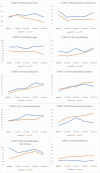Quality of life of locally advanced cervical cancer patients after neoadjuvant chemotherapy followed by chemoradiation versus chemoradiation alone (CIRCE trial): a randomized phase II trial
- PMID: 32321767
- PMCID: PMC7362881
- DOI: 10.1136/ijgc-2019-001134
Quality of life of locally advanced cervical cancer patients after neoadjuvant chemotherapy followed by chemoradiation versus chemoradiation alone (CIRCE trial): a randomized phase II trial
Abstract
Objective: The CIRCE trial (NCT01973101) investigated the efficacy, safety, and quality of life of the addition of neoadjuvant chemotherapy with cisplatin and gemcitabine to standard chemoradiation for locally advanced cervical cancer (stages IIB-IVA). The impact of both treatment arms on quality of life is reported in the present study.
Methods: Patients completed the European Organization of Research and Treatment of Cancer questionnaire QLQ-C30 and CX24 before treatment and at 3, 6, 9, and 12 months after treatment. Linear mixed models were fitted to analyze differences in quality of life over time and between groups. Differences in mean quality of life scales >10 points and p<0.05 were considered clinically relevant and statistically significant, respectively. Inclusion criteria were: (1) histological diagnosis of locally advanced invasive carcinoma of the uterine cervix, International Federation of Gynecology and Obstetrics stages IIB-IVA; (2) signed informed consent to participate in the CIRCE trial; and (3) answered at least one quality of life questionnaire. Excluded were patients who did not complete any quality of life questionnaire. Relevant exclusion criteria for the CIRCE trial included Eastern Cooperative Oncology Group performance status >2 and peripheral neuropathy >2. Mann-Whitney U tests were performed to assess differences between groups in quality of life at baseline. To evaluate differences between treatment arms, linear mixed models were fitted using the transformed quality of life scores as a dependent variable and time of follow-up and study arm as factors.
Results: A total of 107 patients were enrolled (n=55 neoadjuvant chemotherapy arm; n=52 chemoradiation arm). Quality of life compliance rates were higher for the chemoradiation group at every assessment time (ranging from 75-86.5% in the chemoradiation arm vs 55-81.8% in the neoadjuvant chemotherapy arm). For quality of life results at baseline, no statistically significant difference between the groups was seen. For both groups, most scales showed improvements over time, except for worsening of the summary score, sexual enjoyment, peripheral neuropathy, and menopausal symptoms. For chemoradiation, body image was lower (p<0.001) and patients presented more lymphedema (p<0.001) and sexual worry (p<0.001) at 12 months compared with baseline. Comparing study arms, neoadjuvant chemotherapy showed significantly lower scores in the menopausal symptoms scale (p=0.03) and higher scores for sexual/vaginal functioning (p=0.01). At 12 months, clinical differences were seen only for body image and menopausal symptoms scale, with neoadjuvant chemotherapy presenting better body image scores and a lower burden of menopausal symptoms.
Conclusion: After treatment for locally advanced cervical cancer, patients improved in most quality of life aspects. However, worsening was observed in sexual enjoyment, peripheral neuropathy, and menopausal symptoms. To improve patients' quality of life, efforts should be made to prevent and treat these long term effects of locally advanced cervical cancer treatment.
Keywords: quality of life (PRO)/palliative care; uterine cervical neoplasms.
© IGCS and ESGO 2020. Re-use permitted under CC BY-NC. No commercial re-use. Published by BMJ.
Conflict of interest statement
Competing interests: None declared.
Figures



Similar articles
-
Neoadjuvant Chemotherapy With Cisplatin and Gemcitabine Followed by Chemoradiation Versus Chemoradiation for Locally Advanced Cervical Cancer: A Randomized Phase II Trial.J Clin Oncol. 2019 Nov 20;37(33):3124-3131. doi: 10.1200/JCO.19.00674. Epub 2019 Aug 26. J Clin Oncol. 2019. PMID: 31449470 Clinical Trial.
-
Concomitant chemoradiation versus neoadjuvant chemotherapy in locally advanced cervical carcinoma: results from two consecutive phase II studies.Ann Oncol. 2002 Aug;13(8):1212-9. doi: 10.1093/annonc/mdf196. Ann Oncol. 2002. PMID: 12181244 Clinical Trial.
-
Health-related quality of life in locally advanced cervical cancer patients treated with neoadjuvant therapy followed by radical surgery: A single-institutional retrospective study from a prospective database.Gynecol Oncol. 2019 Sep;154(3):583-589. doi: 10.1016/j.ygyno.2019.07.005. Epub 2019 Jul 12. Gynecol Oncol. 2019. PMID: 31307665
-
Neoadjuvant chemotherapy followed by surgery in cervical cancer: past, present and future.Int J Gynecol Cancer. 2022 Mar;32(3):260-265. doi: 10.1136/ijgc-2021-002531. Int J Gynecol Cancer. 2022. PMID: 35256411 Review.
-
Are we making progress in curing advanced cervical cancer-again?Int J Gynecol Cancer. 2024 Dec 2;34(12):1940-1945. doi: 10.1136/ijgc-2024-005572. Int J Gynecol Cancer. 2024. PMID: 38986568 Free PMC article. Review.
Cited by
-
The research landscape of the quality of life or psychological impact on gynecological cancer patients: A bibliometric analysis.Front Oncol. 2023 Feb 7;13:1115852. doi: 10.3389/fonc.2023.1115852. eCollection 2023. Front Oncol. 2023. PMID: 36824135 Free PMC article. Review.
-
The anti-PD-1 era of cervical cancer: achievement, opportunity, and challenge.Front Immunol. 2023 Jul 25;14:1195476. doi: 10.3389/fimmu.2023.1195476. eCollection 2023. Front Immunol. 2023. PMID: 37559727 Free PMC article. Review.
-
Locally Advanced Cervical Cancer: Neoadjuvant Treatment versus Standard Radio-Chemotherapy-An Updated Meta-Analysis.Cancers (Basel). 2024 Jul 15;16(14):2542. doi: 10.3390/cancers16142542. Cancers (Basel). 2024. PMID: 39061182 Free PMC article. Review.
-
Neoadjuvant Chemotherapy Followed by Concurrent Chemoradiation Versus Adjuvant Chemotherapy Following Concurrent Chemoradiation for Locally Advanced Cervical Cancer: A Network Meta-Analysis.Cancers (Basel). 2025 Jan 11;17(2):223. doi: 10.3390/cancers17020223. Cancers (Basel). 2025. PMID: 39858005 Free PMC article.
-
LINC00294 induced by GRP78 promotes cervical cancer development by promoting cell cycle transition.Oncol Lett. 2020 Nov;20(5):262. doi: 10.3892/ol.2020.12125. Epub 2020 Sep 21. Oncol Lett. 2020. PMID: 32989396 Free PMC article.
References
-
- INCA Available: http://www.inca.gov.br [Accessed assessed in October 2018].

